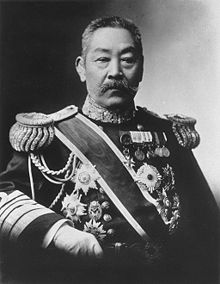Itō Sukeyuki
Count Itō Sukeyuki Y đông hữu hừ | |
|---|---|
 | |
| Native name | Y đông hữu hừ |
| Born | 20 May 1843 Kagoshima,Satsumadomain, Japan |
| Died | 16 January 1914(aged 70)[1] Tokyo,Japan |
| Allegiance | |
| Service/ | |
| Years of service | 1871–1907 |
| Rank | |
| Commands | |
| Battles/wars | |
| Awards |
|
Marshal-AdmiralCountItō Sukeyuki(Y đông hữu hừ,Itō Sukeyuki;also known asItō Yūkō)(20 May 1843 – 16 January 1914) was a Japanese career officer and admiral in theImperial Japanese NavyinMeiji-periodJapan.
Biography
[edit]Born in what is now part ofKagoshima Cityas the son of asamuraiof theSatsuma Domain,Itō studiednaval engineeringandgunneryat theKobe Naval Training Centertogether withSakamoto RyōmaandMutsu Munemitsu.He participated in theAnglo-Satsuma Waras a member of the Satsuma domain's navy. Before theBoshin War,Itoh had already relocated toEdoand had placed his naval skills at the service of the forces striving to overthrow theTokugawa Shogunate.He escaped from the burning of the Satsuma Domain residence in Edo and subsequently fought in many of the naval engagements of the Boshin War.
After theMeiji Restoration,Itō was commissioned as alieutenantand served on thecorvetteNisshinin the fledgling Imperial Japanese Navy, commanding theNisshinfrom 1877. Promoted tocaptainin 1882, he served on many warships of theImperial Japanese Navyin its pioneer days, notably theRyūjō,Fusō,andHiei.In 1885, he was placed in charge of theYokosuka Naval Arsenal.The same year, he travelled to theUnited Kingdom,and brought theNaniwaback to Japan.
On 15 June 1886, he was promoted torear admiral,and made commandant of theImperial Japanese Navy Academy.He was promoted tovice admiralon 12 December 1892 and made commandant of theYokosuka Naval District.On 20 May 1893, he becamecommander-in-chiefof theReadiness Fleet.
With the start of theFirst Sino-Japanese Warin 1894, he became the first Commander-in-Chief of theCombined Fleetand won several naval battles against theChinese Empire'sBeiyang Fleetled by AdmiralDing Ruchang,notably at theBattle of the Yellow Sea.
On 11 May 1895, Itō became Chief of theImperial Japanese Navy General Staff.In 1898, and was ennobled with the title ofshishaku(viscount) on 5 August 1898 under thekazokupeerage system. He was promoted to fulladmiralon 28 September 1898.

During theRusso-Japanese Warhe continued to serve as head of the Navy General Staff. After the war, he becamemarshal admiralon 31 January 1905, and histitle of nobilitywas raised to that ofhakushaku(count) in 1907. At the same time, he was awarded theOrder of the Golden Kite(1st class) and the Grand Cordon of the SupremeOrder of the Chrysanthemum.
Itō professed to have absolutely no interest in politics whatsoever, but was unofficially regarded as one of thegenrōby his contemporaries.
Itō died in 1914. His grave is at the temple of Kaian-ji inShinagawa,Tokyo.
References
[edit]Books
[edit]- Dupuy, Trevor N (1992).Encyclopedia of Military Biography.I B Tauris & Co Ltd.ISBN1-85043-569-3.
- Paine, S.C.M (2002).The Sino-Japanese War of 1894–1895: Perceptions, Power, and Primacy.London: Cambridge University Press.ISBN0-521-81714-5.
External links
[edit]- Nishida, Hiroshi."Itoh Sukeyuki".Imperial Japanese Navy.Archived fromthe originalon 4 December 2012.Retrieved14 August2006.
Notes
[edit]- ^Nishida,Imperial Japanese Navy.
- 1843 births
- 1914 deaths
- People from Kagoshima
- People from Satsuma Domain
- Samurai
- People of Meiji-period Japan
- Imperial Japanese Navy marshal admirals
- People of the Boshin War
- Japanese military personnel of the First Sino-Japanese War
- Japanese military personnel of the Russo-Japanese War
- Kazoku
- Shimazu retainers
- Recipients of the Order of the Golden Kite
- Recipients of the Order of the Plum Blossom
